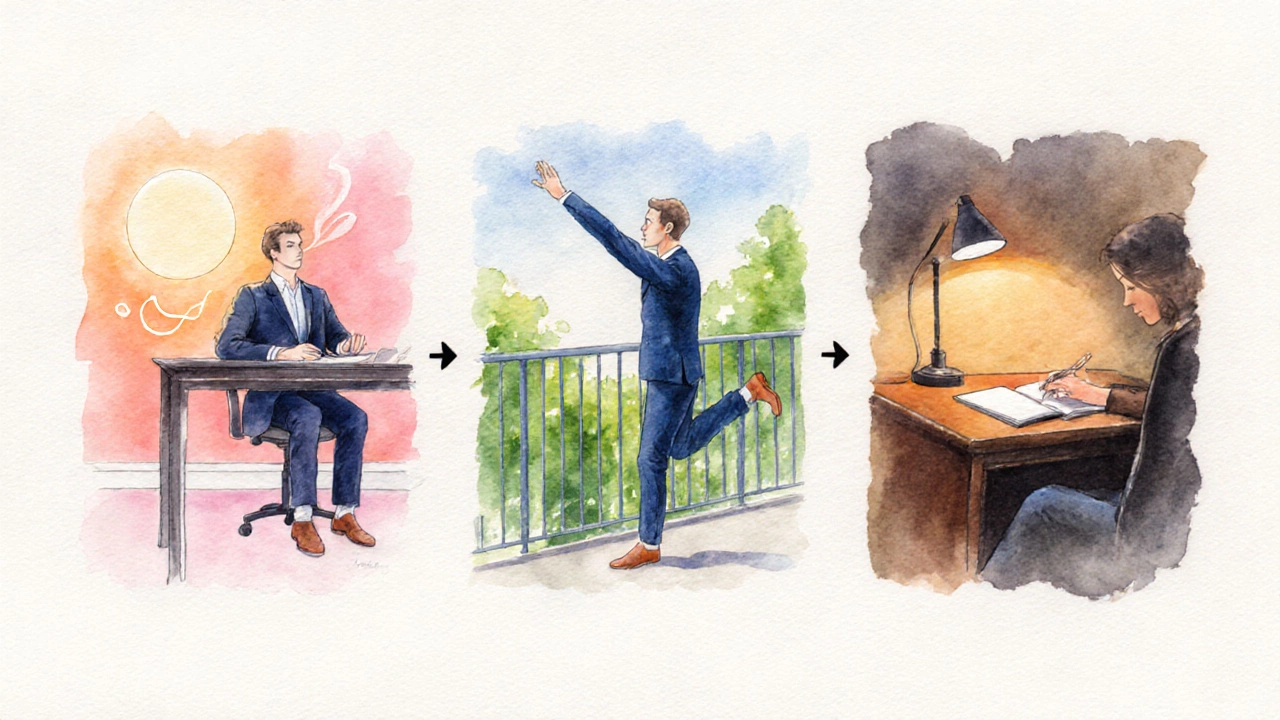Negative Thought Control: Technique Selector
Select your current situation to get personalized technique recommendations for managing negative thoughts.
Your Personalized Strategy
Ever find your mind drifting into a spiral of doubt just before an important meeting or after a long day? Those intrusive, self‑critical loops are more than a nuisance; they sap confidence and erode the calm composure a gentleman strives to maintain. The good news is that negative thoughts are habits, and like any habit, they can be retrained with the right routine.
Quick Takeaways
- Identify the trigger and label the thought within 30 seconds.
- Apply a 5‑minute mindfulness or breathing pause to reset the nervous system.
- Reframe the narrative using a simple CBT worksheet - "Evidence, Perspective, Action".
- Anchor the day with brief physical activity and a nightly journal entry.
- Maintain sleep hygiene and balanced nutrition to keep the brain’s chemistry steady.
These five pillars form a lightweight yet robust system that fits seamlessly into a busy professional’s schedule.
What Are Negative thoughts is a pattern of self‑critical or pessimistic thinking that can arise spontaneously or in response to stressors?
Negative thoughts are not random; they are the brain’s default error‑checking mode. When the prefrontal cortex flags a potential threat - a looming deadline, a social embarrassment, a financial worry - it often resorts to an over‑generalised narrative: “I’m not good enough,” “I’ll fail,” or “Nobody respects me.” Over time, these narratives become entrenched, driving a feedback loop of cortisol spikes, reduced focus, and diminished confidence.
Why Traditional Will‑Power Falls Short
A gentleman will not simply “try harder.” Will‑power is a finite resource, and neuro‑science shows that after a few minutes of self‑control the brain’s glucose reserves dip, making sustained effort feel like a chore. Instead of taxing will‑power, we enlist structured techniques that automate the response, allowing the mind to shift without conscious strain.
The Core Techniques Every Gentleman Should Master
Below are six evidence‑backed practices, each introduced with a brief definition wrapped in schema markup for clarity.
- Mindfulness is the practice of observing thoughts and sensations in the present moment without judgment. A three‑minute pause on the breath creates a neural reset, decreasing amygdala activity by up to 30% (Harvard 2023).
- Cognitive Behavioral Therapy (CBT) is a structured, goal‑oriented approach that challenges distorted thinking patterns and replaces them with realistic alternatives. Even a single CBT worksheet can cut the intensity of a negative thought by half.
- Meditation is a focused attention exercise, typically on breath or a mantra, that cultivates mental clarity and emotional regulation. Regular meditation adds approximately 0.5mm to the prefrontal cortex thickness, improving executive control.
- Physical Exercise is any bodily activity that raises heart rate, from a brisk walk to a weight‑lifting session. Endorphin release during exercise produces a natural anti‑depressive effect within 10-15 minutes.
- Journaling is the habit of recording thoughts, emotions, and reflections on paper or digitally. A nightly five‑minute log externalises rumination, freeing working memory for next‑day tasks.
- Breathing Technique is a controlled respiration practice such as the 4‑7‑8 method, which activates the parasympathetic nervous system. This reduces heart rate variability and calms the nervous system within seconds.
Crafting a Daily Resilience Routine
Integrating these practices need not disrupt a demanding schedule. Below is a streamlined, time‑efficient routine tailored for a professional gentleman.
- Morning Reset (5minutes)
- As soon as you sit at your desk, close your eyes and run the 4‑7‑8 breathing cycle twice.
- Open a mindfulness app (or simply focus on the sensation of breath) for a three‑minute awareness session.
- Midday Check‑In (2minutes)
- When you notice a negative thought, label it aloud: “I’m feeling self‑doubt.”
- Take a quick stand‑up stretch or walk to the kitchen and sip water - the movement interrupts the loop.
- Evening Reflection (5minutes)
- Write a brief journal entry: note the thought, the evidence for and against it, and a concise action plan.
- Finish with a ten‑minute meditation or a calm breathing session before sleep.
This routine adds roughly 12 minutes to a day, a modest investment for sustained mental clarity.
Technique Comparison
| Technique | Time per Session | Immediate Impact | Best For | Tools Needed |
|---|---|---|---|---|
| Mindfulness | 3‑5min | Calm nerves, reduce rumination | High‑stress meetings | Quiet space, optional app |
| CBT Worksheet | 5‑10min | Reframe thought, actionable plan | Complex, recurring doubts | Printed sheet or notes app |
| Physical Exercise | 10‑30min | Endorphin boost, mood lift | General fatigue, low energy | Gym clothes or a brisk walk |

Checklist: Keep Your Mind Sharp
- Identify triggers within 30 seconds.
- Label the thought (e.g., “self‑criticism”).
- Choose a technique - breath, mindfulness, or CBT - based on time available.
- Execute the chosen technique deliberately.
- Log the outcome in your journal.
- Review weekly to spot patterns and adjust.
Common Pitfalls and How to Avoid Them
Pitfall 1: Over‑Analyzing - Trying to dissect every thought leads to paralysis. Stick to the three‑step label‑choose‑act framework.
Pitfall 2: Inconsistency - Skipping days erodes the habit loop. Set a calendar reminder; treat the routine like a grooming appointment.
Pitfall 3: Relying Solely on Will‑Power - As earlier noted, will‑power wanes. Automate the process with cues (e.g., a coffee cup signals a breathing pause).
Next Steps: Tailor the System to Your Lifestyle
Begin by picking one technique to focus on for a week. Record your observations. After seven days, add a second technique. Within a month you’ll have a personalized arsenal that feels as natural as a well‑cut suit.
Frequently Asked Questions
Can I use these techniques without professional guidance?
Yes. The methods described are self‑administered and evidence‑based. However, if negative thoughts persist or intensify, seeking a qualified therapist is advisable.
How long before I notice results?
Most gentlemen report a measurable shift within one week of consistent practice, especially after implementing the breathing and mindfulness pauses.
What if I have only 5 minutes between meetings?
A quick 4‑7‑8 breath cycle followed by a one‑minute mental label is sufficient to break the loop and restore composure.
Is journaling really necessary?
Journaling externalises the thought, preventing it from looping inside your mind overnight. A short entry is a powerful anchor for long‑term mental resilience.
Do diet and sleep affect my thought patterns?
Absolutely. Poor sleep spikes cortisol, while high‑sugar meals can destabilise neurotransmitters. Aim for 7‑8hours of sleep and a balanced diet rich in omega‑3s to support mood stability.
By embedding these practices into the cadence of your day, you’ll discover that negative thoughts lose their grip, leaving space for clear thinking, confident decision‑making, and the steady poise that defines a modern gentleman.

